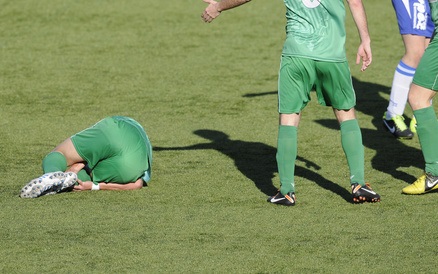Although football is essentially a non-contact sport, it is still possible to pick up injuries whilst playing the game.
Research has shown that there are around 20 injuries per 1000 hours of football played. Injury rates in adolescents are roughly 8 injuries per 1000 hours of football played. Research into football injuries also shows that female footballers are more likely to be injured than their male counterparts.
The majority of these injuries occur below the waist and are caused by some form of trauma. This trauma may involve another player, but it may just be caused by landing in a difficult position or falling awkwardly. However, around a quarter of sampled football injuries are caused by overuse or strain.
Understanding the main injuries which are suffered by footballers can help to reduce the likelihood of these injuries occurring.
Hamstring
It is estimated that around 40% of all football injuries are hamstring injuries.
Stretching the hamstring muscles beyond their natural limits will cause the muscle tissues to tear. The muscle becomes more susceptible to tearing when the player starts to feel fatigued.
The likelihood of suffering a hamstring injury can be reduced by warming-up properly before matches or intensive training. Muscles have a greater extension when they have been warmed up by one or two degrees.
If you do suffer a hamstring injury, you are advised to treat the muscle with rest, ice, compression and elevation. When applying ice to the affected area, use an ice pack rather than applying ice directly to your skin. The amount of rest that will be required will depend on the severity of the strain. More on treating a hamstring injury is shown in the video.
Sprained Ankle
A sprained ankle is caused by forces acting on the ankle in an unnatural direction. Trying to twist the ankle in an unnatural direction will cause soft tissue damage to the area. The ligaments and the capsule which surround the ankle are the most likely areas of the ankle to be damaged. You may notice swelling and bruising after suffering from this sort of injury.
Taping or bracing the ankle may reduce the risk of sprains. Balance and proprioception training can also help players to land and fall in a way that reduces the risk of suffering a sprain. Ankles may become more susceptible to spraining once an initial sprain has already occurred.
Protection, rest ice, compression and elevation are the best treatments for a sprained ankle. The recovery time will depend on the severity of the sprain. More useful information about the initial treatment of a sprained ankle can be fond in the video.
Knee Cartilage Tear
Torn cartilage accounts for about 1 in every 8 football injuries. Fibrocartilage in the knee can tear if it is twisted or forced to move in an unnatural direction. Small tears will cause a slight irritation in the knee, but larger tears can cause the joint to lock or give way.
The best way to prevent knee cartilage tears is to strengthen the quadriceps and hamstring muscles. This helps to reduce the strain that is placed on the knee joint. Slight tears should heal with physiotherapy, but more significant tears may require surgery.
Hernia
Hernias are one of the most common football injuries to occur above the waist. Groin hernias are also common. Without adequate treatment a hernia may get progressively worse.
Improving muscular strength and stability by doing trunk and pelvis exercises can reduce the likelihood of a hernia as shown in the video below.
If you think that you have suffered a hernia, you should consult a doctor to devise an appropriate treatment plan.
Anterior Cruciate Ligament (ACL)
The ACL connects the thigh bone to the shin bone. It serves to prevent excessive movement of the shin and excessive rotation of the knee.
Landing badly after jumping can injure the ACL. Direct tackles to the knee can also damage the ACL. The best way to reduce the likelihood of suffering an ACL is to improve stability using training. This can help players to reduce the risks that are associated with landing badly. The video below should be useful for help in preventing ACL injury.
In the immediate aftermath of an ACL injury, you should treat the area with a combination of protection, rest, ice, compression and elevation. You should seek the advice of an orthopaedic doctor as soon as you can. They will help you to develop an appropriate plan for long term rehabilitation.
